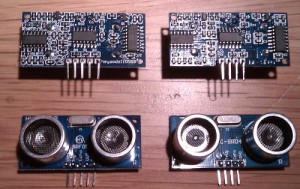Both these ultrasonic range modules are fairly cheap modules, expect the HY-SRF05 to be the more expensive of the these two.
At a quick glance there are only small differences between these two:
| HC-SR04 | HY-SRF05 | |
| Working Voltage | 5 VDC | 5 VDC |
| Static current | < 2mA | <2 mA |
| Output signal: | Electric frequency signal, high level 5V, low level 0V | Electric frequency signal, high level 5V, low level 0V |
| Sensor angle | < 15 degrees | < 15 degrees |
| Detection distance (claimed) | 2cm-450cm | 2cm-450cm |
| precision | ~3 mm | ~2 mm |
| Input trigger signal | 10us TTL impulse | 10us TTL impulse |
| Echo signal | output TTL PWL signal | output TTL PWL signal |
| Pins |
|
|
Not sure what the out pin is about, I have seen claims that it goes
high when it detects a obstacle.
From my personal observations the HY-SRF05 seems like a slightly more
accurate sensor and seems to have a much better range [I even got it
to measure beyond the 4.5 meters it claims] Ė but if I were to build
for instance a robot that should not collide with a wall that would
not matter.
In short a ultrasonic sensor like this works like:
| Send a pulse signal to I/O TRIG which is at least 10us long, this will activate the module to start detecting | |
| The ultrasonic module will automatically send eight 40khz square waves, and will automatically detect when there is a reflect signal; | |
| When there is an reflect signal back, the ECHO I/O will output a high level, the duration of the high-level signal is the time from untral sonic launch to return. As a result, the Measured distance = (T(Time of High Level output ) * (340M / S)) / 2The reason for the division by two is that since this is a echo it has traveled both to and from the object. Note the speed of sound is dependent of the temperature so keep that in mind if you need accuracy |
And here comes a code sample that works with both of these
And something that I noticed is very important is the quality of the 5V I got from my USB port when the Arduino was hooked up. At first I got a very noisy signal that was only able to detect ranges of about 10 cm, but after I swapped the connection to not use a usb-hub the results were much better.
And to finish off here comes a bit more about how to calculate the distance based on the time for the sound:
c = 331.3 + 0.606 ◊ Temperature_in_C
so for 20 degrees it would be
c = 331.3 + 0.606 ◊ 20 = 343.42 m/s
And for a lot better explenation, check out wikipedia



Muito obrigado pela explicacao porque o entendimento esta claro como ainda nao encontrei em outra parte!!!vlw mesmo pela divulgacao, abs
Hello, I think that OUT pin is to use 2 pins trigger and echo or 1 pin (trigger) like old SRF005 did. OUT pin spare means 2 pin. OUT pin to GND means one pin. Interesting blog. Regards.
I hava one question, itís about the last formula, which explains the relation between soundís celerity and temperature
c = 331.3 + 0.606 ◊ Temperature_in_C
what does 331.3 refers to ?
thank you.
nice
itís the speed of sound at the freezing temperature.
alles clear